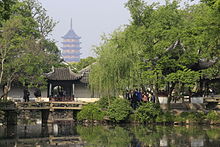Humble Administrator's Garden
| Classical Gardens of Suzhou | |
|---|---|
| Name as inscribed on the World Heritage List | |
 |
|
| Location |
|
| Type | Cultural |
| Criteria | i, ii, iii, iv, v |
| Reference | 813 |
| UNESCO region | Asia-Pacific |
| Inscription history | |
| Inscription | 1997 (21st Session) |
| Extensions | 2000 |
| Humble Administrator's Garden | |||||||||||||||||||||||||

"Humble Administrator's Garden" in Simplified (top) and Traditional (bottom) Chinese
|
|||||||||||||||||||||||||
| Simplified Chinese | 拙政园 | ||||||||||||||||||||||||
|---|---|---|---|---|---|---|---|---|---|---|---|---|---|---|---|---|---|---|---|---|---|---|---|---|---|
| Traditional Chinese | 拙政園 | ||||||||||||||||||||||||
|
|||||||||||||||||||||||||
| Transcriptions | |
|---|---|
| Standard Mandarin | |
| Hanyu Pinyin | Zhuōzhèng yuán |
| Wade–Giles | Cho1-cheng4 yüan2 |
| IPA | [ʈʂwó.ʈʂə̂ŋ ɥɛ̌n] |
| Wu | |
| Romanization | Tsoh-tsen yoe |
| Yue: Cantonese | |
| Yale Romanization | Jyut-jing yùhn |
| Jyutping | Zyut3-zing3 jyun4 |
| Southern Min | |
| Tâi-lô | Tsuat-tsìng hn̂g |
The Humble Administrator's Garden (Chinese: 拙政园; pinyin: Zhuōzhèng yuán; Suzhou Wu: IPA: [tsoʔ tsen ɦyø]) is a Chinese garden in Suzhou, a UNESCO World Heritage Site and one of the most famous of the gardens of Suzhou. The garden is located at 178 Dongbei Street (东北街178号). At 51,950 m2, it is the largest garden in Suzhou and is considered by some to be the finest garden in all of southern China.
On the garden's site was first built a garden during the Shaoxing period (1131-1162) of the Southern Song Dynasty. Afterwards it changed ownership, and was destroyed or modified continually. It was the residence and garden of Lu Guimeng, a Tang Dynasty scholar. Later in the Yuan Dynasty it became the Dahong Temple's garden.
In 1513, Wang Xiancheng, an Imperial Envoy and poet of the Ming Dynasty created a garden on the site of the dilapidated Dahong Temple which had been burnt during the Ming conquest. In 1510, he retired to his native home of Suzhou on the occasion of his father's death. He had experienced a tumultuous official life punctuated by various demotions and promotions, and gave up his last official post as magistrate of Yongjia county in Zhejiang province, and began to work on the garden. This garden, meant to express his fine taste, received close attention from the renowned artist, Suzhou native, and friend, Wen Zhengming. The garden was named (first evidence around 1517) after a verse by the famous scholar official of the Jin Dynasty, Pan Yue, in his prose, An Idle Life, "I enjoy a carefree life by planting trees and building my own house...I irrigate my garden and grow vegetables for me to eat...such a life suits a retired official like me well." This verse symbolized Wang's desire to retire from politics and adopt a hermits life in the manner of Tao Yuanming. In the Xianju rhyme-prose, he writes 'This is the way of ruling for an unsuccessful politician'. It took 16 years until 1526 to complete. Wen Zhenming wrote an essay Notes of Wang's Humble Administrator's Garden, and painted Landscapes of the Humble Administrator's Garden in 1533 including 31 paintings and poems to commemorate the garden. Wen produced a second album of eight leaves showing sites in the garden in 1551, with different views but the same poems as in 1533.
...
Wikipedia
